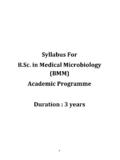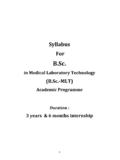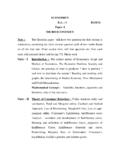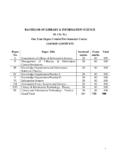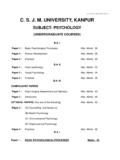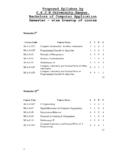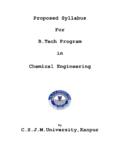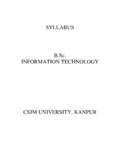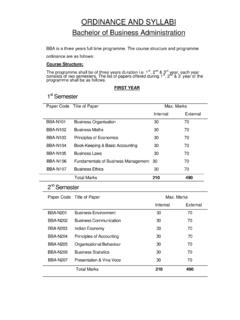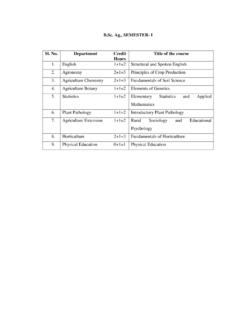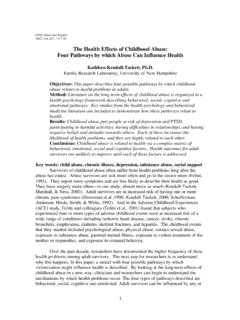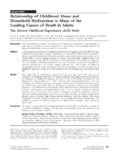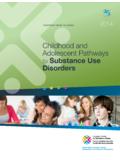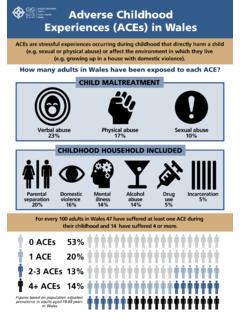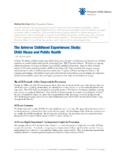Transcription of EARLY CHILDHOOD CARE & EDUCATION
1 SUB EARLY CHILDHOOD care & EDUCATION 1st year Paper I (Theory) COURSE TITLE : CHILD DEVELOPMENT (BASIC COURSE) COURSE CONTENT Unit : I The field of Child Development and basic concepts A. Growth, development & principles of child development. B. Importance of studying children in the contemporary context. C. Nature and Scope of child development. D. Fundamental concepts of Child Development. Understanding the conceptual heredity and environment maturation & learning, health and nutrition, factors determining development. Developmental areas, developmental tasks. E. General principles of growth and development Unit : II Methods of studying children A. Cross-sectional and longitudinal approaches. Observation techniques, interview, questionnaire. B. Projective Techniques Unit : III Birth and neonatal period.
2 A. Conception and fetus development B. Factors affecting prenatal development with special emphasis on the need and nutrition care in pregnancy. C. Birth process Normal, birth, Caesarean section, Complication at birth, care required. D. Assessing normal, premature, small for date and large for date babies. E. Neonatal care and adjustment; development in the first 4 weeks. F. Breast feeding its importance for mother and baby, antenatal preparatic natal support, combating likely problems, hygiene with respect to breast. Unit : IV Physical growth, motor development and health care . A. A brief overview of the physical and physiological changes B. Milestones in motor development : Gross and finer muscle skills C. Nutritional needs of infants, toddlers and preschoolers D. Diet planning E.
3 Nutrition related disorders, prevention and management PEM, anaemia F. Prevention and management of common CHILDHOOD illnesses Respiratory illnesses Problems of Ear, Eye, teeth etc. Infectious diseases Diarrhoea, its management Immunization Unit : V Socio-emotional development A. Components and stages of social development B. A brief overview or different theoretical view points pertaining to socio-emotional development C. Socialization and agents of socialization. D. Nature and types of children's emotions. E. Factors affecting emotional development F. Helping children to acquire emotional maturity. Unit : VI Language Development A. Defining language development B. Sequence of language development including its social and cultural aspects. Unit : VII Cognitive Development A. What is cognition ?
4 B. Content / Stages of cognitive growth in CHILDHOOD . C. Views of Piaget D. Concept development in young children. E. Creativity in relation to cognitive development. Unit : VIII Personality Development A. Meaning of Personality B. Role of genetic and environmental factors in shaping personality characteristics C. Personality as a function of culture and child-rearing. 1st year Paper II (Theory) COURSE TITLE : FAMILY AND CHILD IN TODAY'S CONTEXT Unit : I Basic Concepts : A. Definitions : Society, family, marriage B. Family in socio-cultural context. i. Linkages between family, society and social organizations. ii. Types of familial organization, their roles eg. matriarchal, patriarchal, partrilinial, monogamy, polygamy, incest and so on. iii. Children as part of the dynamic ecocultural system. Socio-demographic diversity : Universalities differences ii.
5 Child rearing and socialization : The India View iii. Rights of the child in context of demographic profile of the Indian child. Unit : II Understanding family in a changing social context with special focus on India. i. Employment and occupation trends, including migration ii Ecological situation and environment Micro determinants and their implications on family life in general and children in particular. i. Dynamics of family size and structure and family life cycle. ii. Changing functions : their implications on individual roles, including the following : - Family headship, female headed households. - Women's productive and reproductive roles : match v/s mismatch. Unit : III Families in different circumstances : Effect on children. A. Impact of difficult living conditions and coping mechanisms. Examples : i. Poverty, unemployment, consumerism and materialism.
6 Ii. Problems with meeting survival needs. iii. Alcoholism & drug abuse. iv. Oppressed families (caste/class etc.) v. Refugee families, families at risk. B. Social Problem that affect children and coping strategies. i. Desertion, divorce, single parenthood. ii. Migration iii. Family Violence Unit : IV Need for support services to enhance quality of life of families A. Issues and concerns related to family with special focus on children. i. The girl child in the family variations in her status. ii. Children in difficult circumstances examples. - Child abuse and violence - Child Marriages. Services should be discussed in view of the national, regional initiatives, concepts approaches. B. Support Services : Need strategies and approaches i. Health ii. EDUCATION iii. Child care iv. Play and recreation BA 1st Year Paper III (Practical) Activities for young children 1.
7 Preparation of growth chart 2. Demonstration of Measurement of growth height, weight, mid arm circumference etc. 3. Preparing a Short Project on (anyone) 1. Breast Feeding practices and problems 2. Supplementary feeding to children 3. Prenatal care 4. Problems in Pregnancy 5. Problems in Children's Growth 6. CHILDHOOD illnesses 4. Observing activities in pre-schools or day care centres 5. Organizing visits are an urban slum setting or village setting. 6. Preparation of Language Kits (anyone) 1. Story telling techniques 2. Flash Cards 3. Sequence Cards 4. Alphabet Cards 5. Colours and Shapes 6. Vegetables Card 7. Fruits Card 8. Visual discrimination booklets 7. Preparation of story books & song books for children 8. Listing games to promote various developments 9. Activities for physical and motor development which enhance large and finer muscular skills type of equipment and materials required to promote physical and motor skills.
8 10. Activities for social and emotional development activities which promote social and emotional development. 11. Activities for cognitive development 12. Activities for language development 13. Prepare a collage on various development IInd year Paper I (Theory) COURSE TITLE : GUIDING YOUNG CHILDREN Course Content Unit : I Overview of Development A. Various aspects of development in terms of how children grow and learn Unit : II Guidance and discipline A. What is Guidance ? B. What is Discipline ? C. Techniques of Guidance ? D. Principles of Guidance ? E. Common do's and don'ts in dealing with children. Unit : III Role of the family in guidance of children. A. Mother and father's role in child development and parental control. B. Sibling's role. C. Definition and significance of adult-child interaction and regulation.
9 D. Parental regulation during - Infancy - 3-5 years - 5-7 years Unit : IV Understanding different community settings and guiding parents therein. A. The Urban slum / disadvantages setting B. Village as a Community. C. Needs of middle class parents. Unit : V Methods of working with and guiding the community Communication : Strategies, methods, aids i. Group Meetings ii. Draw and Dialogue iii. Open ended stories iv. Role Play v. Puppet Theatre vi. Use of Audio-visuals:slides, films (Commercial & Documentaries) vii. Training Workshops Unit : VI Guiding children with behavioural difficulties A. Play, toys and child development. B. Common child-rearing practices and consequences for child development. C. Common behaviour problems (nail, biting. bed wetting etc.)
10 D. How to deal with common behaviour problems. Unit : VII Identification and guidance of children 'at risk' A. Developmental delay B. Who are 'at risk' children ? C. Significance of EARLY identification and prevention of disabilities. D. Screening techniques for children at risk - Examination - Specific Tests - Observation Checklists - Screening devices for specific improvement E. Approaches to work with children. IInd year Paper II (Theory) COURSE TITLE : EARLY CHILDHOOD care AND EDUCATION Course Content Unit : I EARLY CHILDHOOD EDUCATION A. Importance of EARLY CHILDHOOD years. B. What is EARLY CHILDHOOD EDUCATION ? definition, scope and its significance C. Goals and Objectives of EARLY CHILDHOOD EDUCATION Unit : II Historical perspective of EARLY CHILDHOOD care and EDUCATION A.
